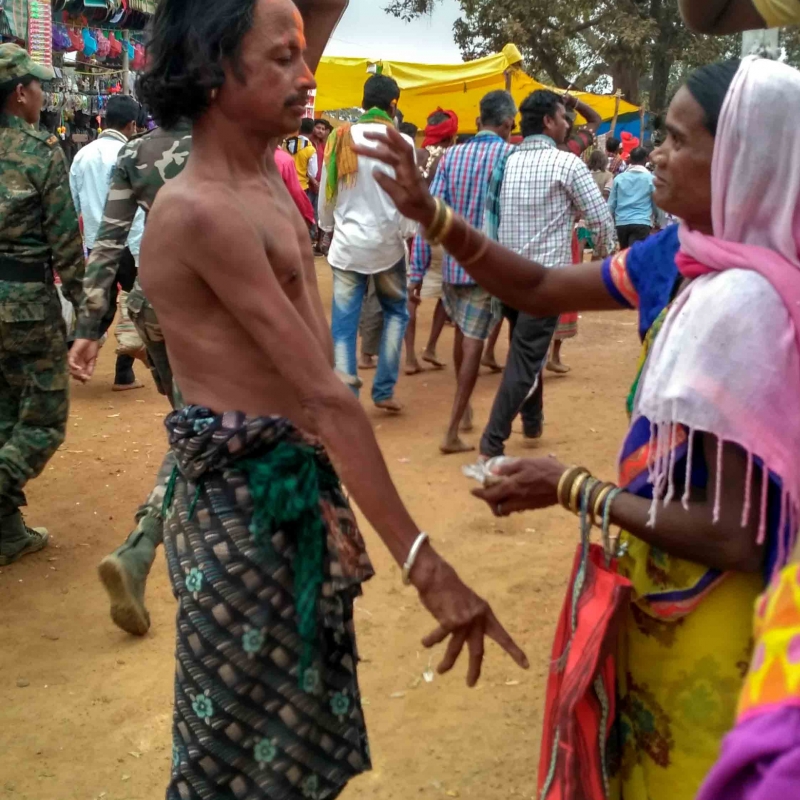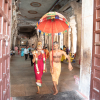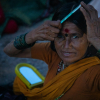According to the census of 2001, the state of Chhattisgarh holds 31.8 percent of the country’s adivasi (original inhabitants) or tribal population. The Gonds are one of the oldest tribes who dwell in the state. Men and women of this tribe celebrate their allegiance to the village god or goddess once a year. This day of celebration and offerings is called Madai or the Madai Festival.
The Madai Festival that reflects the philosophy and ethos of the Gonds also projects the rich culture and tradition of the state. Not only do these celebrations reflect several aspects of Gond life, they also form part of the community celebration where people from different regions gather to rejoice and celebrate.
This festival is celebrated in different ways and on different days across the state. It is a day when the members of the village, their relatives and friends, gather to celebrate the harvest of the preceding year. Madai is the day when the spiritual beliefs of the Gonds are revived and rejuvenated. Gods and goddesses of the village, such as Bada Deo or Shitla Mata, are offered prayers. These prayers and the general atmosphere they evoke are exceptionally grand. Men are an essential part of the celebrations as it is believed that they are possessed by the deities and accept offerings on their behalf. At the same time, household deities embodied by tall bamboo sticks with red or black triangular flags called dang (carried by men) and four wooden logs (made of a specific variety of wood called hira) tied in a square shape called anga (carried by women) are taken to the Madai in a procession. Where the dang is carried by one person (male), angas are carried by four women holding the four corners of the square. Each household invites their relatives and friends from other villages to join them on their festive day. The day after the Madai is called basi Madai, and it is the day when the guests in the house are served. On basi Madai, every house in the village hosts a feast in honour of its guests. Guests are second only to gods; they are offered and served food and treated with great honour and respect on this day.
The approximate time (the month or particular weeks of a month) of when the Madai is to be celebrated, is believed to have been pre-decided by the ancestors of the present members of the tribe. Madais are celebrated from the month of November till the month of April as an essential post-harvest event. It is therefore in the month of November after their harvest has ended that the people manage to have money for such expenditure. This is also a time to enjoy the fruits of their extensive labour during the preceding agricultural season. The bigger Madais (those organized in towns and in cities) are planned in the months of March–April and those organized at a smaller level (village level) are wrapped up before the month of March.
Madais have a deep connection with the processes of the market. In the rural areas of Chhattisgarh, markets or bazaars are organized on one given day of the week in any one particular village. Neighbouring villages visit the market on this day to buy their weekly ration of vegetables, spices, utensils, clothes and other everyday necessities. Thus, the entire area is, as if divided into clusters, and each cluster has one village that hosts the market. Each year, it is necessarily in this village that the Madai is organized, and deities of the member villages in the cluster are invited to the celebrations.
Choice of the date for the Madai is made such that vendors do not go to any other Madai on the same day, and there are enough sellers for refreshments, posters, clothes, kitchen essentials, vegetables, etc. This is so because it is mandatory for the Madai to host a market for the pleasure and satisfaction of its visitors. Thus, this event is a commercial-spiritual juncture. Or, perhaps one can say that life in the rural (villages of Chhattisgarh) does not compartmentalize religion, spirituality, economic practices and modes of socialization.
Consequently, it is only after consulting with the deities does the priest along with the elder men of the village, decide the exact date of the Madai celebrations, albeit within the stipulated time period. It is ensured that this day does not overlap with the Madais in other villages so that more vendors and visitors can join in. In cases of small Madais, the weekday is is also pre-determined, for the Madai is only celebrated on the day the market or bazaar is organized in or around a village.
Madai, however, does not feature as a mandatory event. If the village believes or feels that the deities they worship are angry with them i.e., if the village has been hit by an endemic, has faced drought or floods the same year, has been undergoing a crisis or there have been frequent deaths, then the festival is postponed till the next year. It is believed that till the time gods and goddesses are not happy, village life would not be peaceful. Thus, there remains nothing to celebrate. Only when the happiness of their deities is reflected in the fruitful practices of the village, is the Madai organized.
Madais are occasions when the village gathers to celebrate together. Though these are festivals honouring gods and goddesses of the village, the magnificence of it attracts even those who are atheists, belong to non-adivasi communities or those who do not have gods and goddesses in their houses.
A distinguishing feature of the Madai is the performance of the nacha (theatre) party. The nacha parties are called from different parts of Chhattisgarh to perform plays throughout the night. At most times, these nacha parties pick up social issues, such as dowry, love marriages, education of the girl child, etc. to spread a message among the audience. Theatre platforms in Chhattisgarh are important public platforms which are used responsibly and sensitively in the community. Men and women from all villages that come under the market cluster gather to relish and appreciate the nacha. The member villages of the cluster may even organize for nachas in their own village for their guests. In the mundane circle of everyday labour in rural space, Madais are days of relief and entertainment. Their added significance stems from the fact that markets and nachas are not everyday occurrences there. When everyday routines are the same, it is this time of the year when men, women and children eagerly wait for a change. The hectic lives of people in the rural spaces, where earnings are based on everyday wage labour, make it difficult for them to meet their relatives. Occasions, such as the Madai and weddings, are where relatives get to see each other.
Madai being an occasion of grand festivity involves tremendous effort and planning before the day or week the festivities begin. The article shall discuss the hidden efforts and struggles that lead to a flawless celebration. In the same regard, we find that the work involved is divided amongst men and women in making the Madai as grand as it is. The festival is primarily conducted by the village where the Madai takes place. Other villages that come under the same market or bazaar are expected to participate in these efforts.
The organization of a grand event like this starts a month before the scheduled date or week when the Madai is to generally take place. The time that the men in the village decide the exact date of the Madai is also the time when they plan collection of money for the same. As the date of the Madai approaches, men start calling meetings for the collection of a decided amount of money from members of the host village. At the same time, the usual vendors of the market are charged a meagre amount for the Madai. This collection sustains the Madai financially. Several villages also provide for bhandaras or food for all viewers; in such cases, grains are also collected from each household. Another activity of prime importance is the ‘offering of flowers’. The offering of flowers is a significant gesture of welcoming the deities when the devdhami or processions with dangs, angas and banas arrive.
The budgeting of the nacha, tent for the nacha, bhandara, flowers, lights, sound system etc. are largely looked into by the men of the village. It is primarily they who decide as to how spectacular and extensive the celebrations would be. This, in turn, is decided by how much money the village can collect for the occasion. Then, there are other issues to be resolved. Which nacha party should be invited depending upon the amount of money charged by them? Would there be printed invitations? Who would be the invitees? These invitations would need to be further distributed by men from the host village to neighbouring villages and their deities. Further, it is also decided by the men of the host village whether there would be a bhandara for all the visitors or only for the artists from the nacha party? What preparations would be needed for the viewers at night? Where would the stage be made and the tent be put up? Where would the spectators be made to sit? Mostly, men and women sit separately in the audience. Thus, two separate spaces are required to be arranged for. At the same time, the nachas are performed through the night; thus, a comfortable sitting arrangement is prescribed. What sitting arrangements will the host village be able to provide? What would arrangements for refreshments be? These remain to be other important questions regarding preparations that are discussed and organized by men in the host village.
Where men primarily take charge of the events of the Madai, women take responsibility of the households. Women make sure that they uphold the essence of Madai in their houses, among the family members. Preparations at home also start a month before the actual festival. The priority remains, cleaning, painting the house and earning enough money for expenditure during the Madai. It takes days for these preparations to seem adequate. Women mix the blue distemper in water and paint the walls with their bare hands. They clean each corner of the house. Each sheet, each curtain in the house is washed. The kitchen, the store, each room in the house is cleaned with precision. It is done so to welcome the guests who would arrive to enjoy the Madai. At the same time it remains the woman’s responsibility to collect enough money for expenditures during the Madai. Families keep paddy, harra and behda (forest products), tamarind and sell them before the Madai so that they have enough money on that day.
The host village requires a vague estimation of the expected gathering to allocate a certain area for the Madai. The decided place for the Madai must have a circular path along which the gods and goddesses would do parikrama, bhavars or take rounds of the sacred land. The procession must take exactly two and a half bhavars or rounds. The procession of people carrying the gods and goddesses that gather from each village, walks along this circular path as they dance and immerse themselves in the sacred mood. The procession is followed by men with several instruments, such as nisan, daphra, mohri and damau. These are specific instruments played only for the gods and goddesses to evoke an atmosphere of devotion. As the intensity of the celebration increases, a moment of trance takes over. This moment of trance is created when an exact synchronization of the music, of the rhythm of the dancing men, of gulal or dry colour in the air and of the euphoria of the huge audience surrounding them, is achieved.

The area where the Madai takes place is required to be cleaned and prepared such that the deities can be welcomed. Largely, it is the menfolk who take this responsibility of cleaning the area for the Madai. Basic arrangements, such as those for water, lighting at night, a place to stay for the gods and goddesses, food for the gods and goddesses etc. have to be arranged accordingly. Thus, water is filled in drums and kept for the usage of the visitors. Temporary tubelights or bulbs are put up to light the area. Temples are prepared to welcome the gods and goddesses. When processions arrive from different villages an overpowering energy enfolds the space. These processions consist of people travelling on foot; they carry deities from each household of the village to the Madai. Men also carry the tools, weapons or bana of their gods and goddesses that they worship. Women are not allowed to carry these weapons. The possessed male members in their dhotis and garlands dance with these tools, play with them and also hit themselves with the same. As the devdhamis or the carriers of the deities bleed through the cuts marked by the banas or their religious tools, the audience fold their hands and greet the deities.
The day prior to the Madai is called the phool Madai. On this day, neighbouring villages worship the deities and make offerings of flowers or garlands. This bears testimony that the gods and goddesses have awakened and would then get ready for their journeys the next day. On the day of the festival before leaving for the Madai. the procession visits each house in the village. As this group of men move around, they blow the turra (a whistle instrument) to inform the people that the procession is approaching. When the procession does so, the women in the house welcome them. They wash their feet, offer flowers and put tika or wet colour and rice on their forehead. It is then that the men of the household with their deities join the procession. When all households have been visited, the procession leaves for the Madai. Similarly, when the procession returns from the Madai, women from each household again welcome them (the devdhamis) to receive their blessings. Women again wash their feet, offer them mandh or alcohol, coconut and some money. After the last household is visited, the procession shares the alcohol and the coconut with all those who followed them.
Women having the responsibility of keeping the household in the festive mood, make sure there is enough variety of food on the day of the Madai and the basi Madai. On the day of basi Madai, not less than five types of food preparations are made. Preparations like these require the family to spend well. At the same time, new clothes are to be bought for all members of the household. The tradition is such that relatives are greeted with money, especially the young children. One must ensure pre-arrangement for all that the relatives would require. It is close to mandatory that every household keeps enough amount of alcohol, mandh or mahua to serve their guests. It is also important that if a relative comes to the house for the first time, or after a long time, they must be greeted with new clothes. This is especially true of women. These preparations necessitate a lot of savings by the family. The calculations and budgeting for all these are done by the women in the house.
Madais are enabled by the invisible labour offered by the men and women of the village. This labour remains unlisted and unacknowledged. It is these efforts that maintain the splendour and glory of Madais in the villages. This piece has attempted to highlight the labour, sweat and struggle behind the lavishness of Madais; to bring out the nuanced planning that makes an event at this scale possible. Men and women together having divided their work, labour towards a collective goal—to ensure enjoyment and satisfaction to them and to the visitors in their village. A splendid event like this is certainly a result of collective labour. The processes that enable this event also underscore the ability of performing collective labour.













